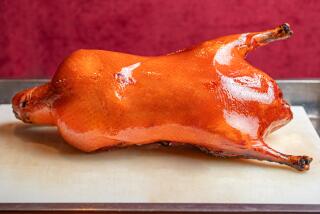Going With the Grain
- Share via
It is unfortunate that such a splendid grain as buckwheat is burdened by the unappealing name of groats. In my family, we called it by its Eastern European name, kasha ; but whatever it was called, I wouldn’t have eaten it the way my grandmother fixed it--pale in color, soft and soupy like a cereal and undistinguished in taste.
When I grew up, a friend reintroduced me to kasha , but her recipe was spicy with black pepper and oregano, and each grain was appealingly dry and separate. The secret was in mixing the buckwheat grains with raw egg and setting it aside for at least 30 minutes, stirring occasionally to keep the grains separate.
Over the years I discovered other secrets such as browning the grains under the broiler after cooking to add crunch and deepen the color; adding sauteed mushroom slices and sometimes a little dried porcini mushrooms for extra flavor, and using stock instead of water. Goose fat is another fabulous flavor enhancement.
Call it what you will, buckwheat has become my favorite grain, and kasha is my traditional accompaniment to roast duck. The earthy, spicy, wheat-y flavor goes so well with the rich crispy duck, I can’t bear to vary it.
Several years ago, the late food writer Bert Greene asked me to make my duck dinner. I had so loudly sung its praises that he wanted to write a newspaper story about it. Other guests for that dinner included Bert’s friend Phillip Schulz, a cookbook author; George and Jenifer Lang, owners of Cafe des Artistes; Blake Swihart, a food consultant, and Howard Solganik, also in the food business, who had flown in from Ohio just for the dinner.
I must admit I went a little overboard. I made the bow-tie noodles from scratch, using duck eggs and a pastry jagger to cut the shapes. I fixed four ducks. For dessert, I made homemade vanilla ice cream with hot fudge sauce and brandied cherries that I had picked and brandied more than five years before.
Never having made more than one duck at a time, I didn’t realize that all that rendered duck fat could ignite in the oven. Luckily, Howard arrived early and took over when I ran screaming from the kitchen, pausing only to hand him my safety goggles.
I suppose you could say the dinner was a success. Howard had saved the duck from cremation and everything turned out just as I had intended, if not just as I had expected.
The surprise was the guests, most of whom arrived with seriously diminished appetites for such a hearty dinner! Bert and Phillip had just come from a cocktail party with lavish hors d’oeuvres, and the Langs had just come from a preview tasting of everything on the menu of the soon-to-be-born restaurant Aurora.
I was starving but felt a little funny going for second helpings when half my guests were having trouble with their first.
One thing was certain--the Kasha Varnishkes, not the duck, was the star of the dinner party. I discovered this when George Lang raised his glass to toast the fact that if he, without appetite, could ask for a second helping of Kasha Varnishkes, the meaning was self-evident.
KASHA VARNISHKES
1/2 ounce dry porcini mushrooms, optional
1 cup kasha (preferably coarse-ground)
1 egg
1/4 cup plus 1 tablespoon goose fat or butter
2 cups chopped onions
1 teaspoon sugar
5 cups sliced fresh mushrooms
1 teaspoon minced garlic
1 teaspoon salt
2 teaspoons freshly ground black pepper
1 tablespoon dried oregano
1 3/4 cups boiling chicken broth
2 cups bow-tie pasta
Soak porcini mushrooms in small amount of warm water until tender. Drain mushrooms. (If desired, reserve soaking water and add to chicken broth to make up 1 3/4 cups liquid.) Cut mushrooms into small pieces. Set aside.
Stir together kasha and egg with fork and set aside to dry 30 minutes, stirring occasionally.
Melt 1/4 cup goose fat in large skillet (preferably broiler-proof) with tight-fitting lid. Add onions along with sugar and saute, stirring often, until well-browned. Add fresh mushrooms and garlic. Cover and cook until mushrooms give up their liquid. Continue cooking uncovered until liquid evaporates.
Add kasha mixture, salt, pepper and oregano. Cook, stirring constantly, 2 or 3 minutes. Stir in chicken broth and porcini mushrooms. Cover tightly and simmer 20 minutes or until liquid is absorbed.
Cook bow-tie pasta according to package directions. Drain and stir in remaining 1 tablespoon goose fat. Mix bow ties into kasha mixture. Makes 4 servings.
Note : If skillet is not broiler-proof, turn kasha mixture into another utensil such as broiler pan and broil several inches from heat, stirring often to brown and prevent scorching. Mix in bow ties.
Each serving contains about:
463 calories; 1102 mg sodium; 92 mg cholesterol; 18 grams fat; 64 grams carbohydrates; 15 grams protein; 2 grams fiber; 36% calories from fat.
More to Read
Eat your way across L.A.
Get our weekly Tasting Notes newsletter for reviews, news and more.
You may occasionally receive promotional content from the Los Angeles Times.










